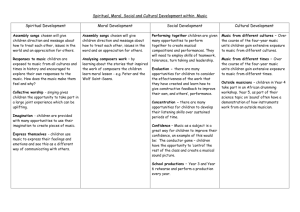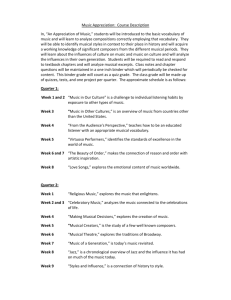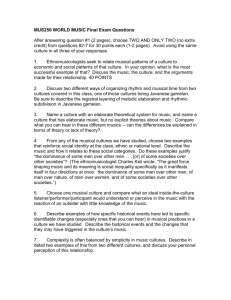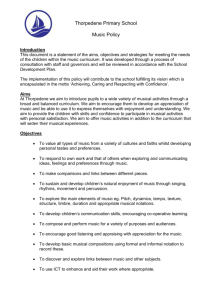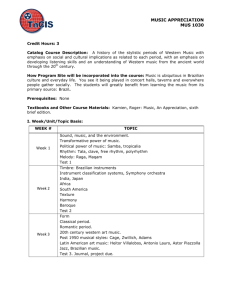Music for Today - Lakewood City Schools
advertisement
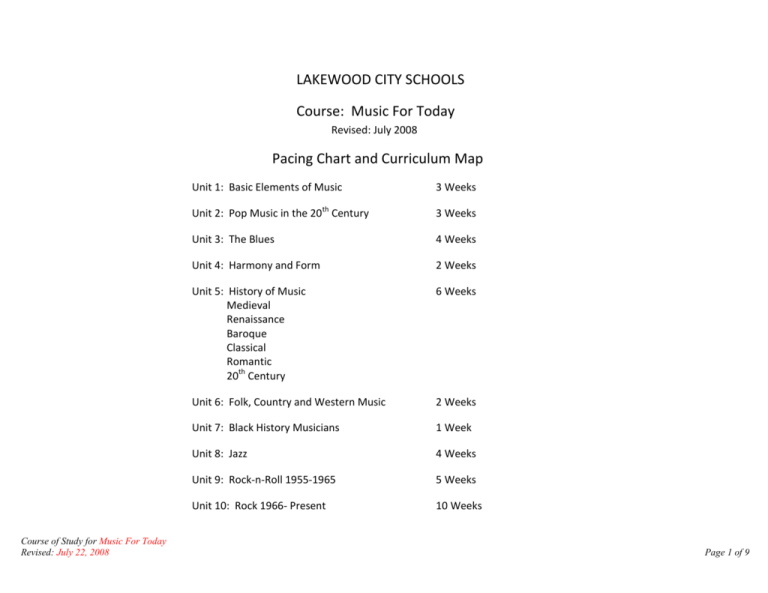
LAKEWOOD CITY SCHOOLS Course: Music For Today Revised: July 2008 Pacing Chart and Curriculum Map Course of Study for Music For Today Revised: July 22, 2008 Unit 1: Basic Elements of Music 3 Weeks Unit 2: Pop Music in the 20th Century 3 Weeks Unit 3: The Blues 4 Weeks Unit 4: Harmony and Form 2 Weeks Unit 5: History of Music Medieval Renaissance Baroque Classical Romantic 20th Century 6 Weeks Unit 6: Folk, Country and Western Music 2 Weeks Unit 7: Black History Musicians 1 Week Unit 8: Jazz 4 Weeks Unit 9: Rock-n-Roll 1955-1965 5 Weeks Unit 10: Rock 1966- Present 10 Weeks Page 1 of 9 Lakewood City Schools Course of Study for Music for Today Revised: July 22, 2008 Scope and Sequence – Music for Today is a high school level music appreciation course designed for students in grades 10 through 12 who desire a more thorough understanding of today’s American music. The course exams all types of music from classical, blues, jazz, rock, world and pop. Emphasis is placed upon listening skills as well as historical and cultural events as they relate to music. The basic elements of music will be used to examine, compare and contrast different genres of music. . Unit Title here A short description of the unit in narrative form goes here. Standard and Benchmark Standard: Grade Level Indicators Clear Learning Targets Strategies/Resources I can… Historical, Cultural and Social Contexts: Students demonstrate knowledge and understanding of a variety of music styles and cultures and the context of musical expression or events, both past and present. Students identify significant contributions of composers and performers to music heritage. Students analyze the historical, social and political forces that have influenced the function and role of music in the lives of people. Benchmark A: Identify music forms Course of Study for Music For Today Revised: July 22, 2008 Page 2 of 9 from various cultures and historical periods and create or perform representative repertoire with stylistic accuracy. 2. Recognize and classify Western music literature by historical periods. 3. Examine (e.g., listening, performing, score study) music literature of various composers. Benchmark B: Research and explain how music and composers both influence and are influenced by society and culture. Course of Study for Music For Today Revised: July 22, 2008 a. I can recognize a Fugue. b. I can recognize Theme and Variations. c. I can recognize ABA form. d. I can recognize a motive or riff. e. I can recognize a phrase. f. I can recognize call and response. 1. Recognize and describe form in music literature of various historical periods. 1. Identify the social context from which music of various cultures evolved. a. Bach’s “Little Fugue in g minor” b. Mozart’s “Surprise Symphony” c. Led Zeppelin’s “Whole Lotta Love” d. Beethoven’s “Symphony No.5” e. The Star Spangled Banner f. Ray Charles “What I’d Say” a. a. I can list the 6 historical time periods of music history and art. b. I can classify the 6 historical time periods of music history. a. a. I can create an outline/form analysis of music from various composers and styles. I can identify secular and sacred music. b. I can identify which time period and genre music came Copy and create a chart listing Medieval, Renaissance, Baroque, Classical, Romantic, and 20th Century. b. List the dates, a few major composers, musical works, or musical characteristics that go with each time period of music history. c. Add important dates and events from political and social history To a time line that includes the six historical periods of Music History and Art. a. Use Eine Klein Nacht Muzik, Whole Lotta Love, Walk This Way, and Jazz Tune. a. Use examples from Renaisance, Baroque and Classical. Page 3 of 9 from. c. I can identify vocal and instrumental music. 2. Explain how technology has influenced the development of music over time. a. I can explain how technology has influenced music in each historical time period. a. 3. Explain how music reflects the political and social events of history. a. I can explain and identify major political and social events that have influenced music. a. b. I can explain and identify major musical compositions and composers that reflect political and social events of history. Describe how instrument making improved with innovations in brass works, metallurgy, and general craftsmanship abilities. b. Describe the invention of the electric guitar and electric bass and how this changed music. Compare music from the 1910’s popularity of Patriotic Music in conjunction with WW I, 1920’s Prohibition, from the 1930’s Great Depression, World War II, Vietnam War and anti war music and attitude, etc. b. Woody Gutherie, Pete Seager and Bob Dylan with their social protest and political activist music. c. Rap/Hip Hop artists that exemplify political commentary in their music. Standard: Analyzing and Responding: Students listen to a varied repertoire of music and respond by analyzing and describing music using correct terminology. Students Course of Study for Music For Today Revised: July 22, 2008 Page 4 of 9 evaluate the creating and performing of music by using appropriate criteria. 1. Describe the use of elements of music as they relate to expression in a varied repertoire of music. a. I can identify the six basic elements of music (melody, harmony, rhythm, timbre, texture, and form) in a variety of musical genres. b. I can explain how the basic elements of music contribute to the expression of a given musical work. a. 2. Analyze a given work on the basis of how elements of music are used in the selection to make it unique. a. I can identify the basic elements of music in a given work and how they function to make the music unique. a. Students bring in examples of their own music and they describe what they hear and what basic element is heard and how the music is unique. 3. Describe compositional devices and techniques (motives, imitation, suspension,) that are used to provide unity, variety, and tension and release in a music work. a. I can identify the motives, riffs, and phrases in a musical work as they provide unity, variety and tension and release a. By listening and analyzing and discussing a wide variety of music in class, students will identify motives, riffs, phrases and identify and show examples of how these provide unity and variety as well as tension and relaxation in music. 1. a. I can identify a Blues Progression (I, IV, V, I). a. Listen to Blues, Jazz and Rock examples first. Then exand to Classical examples. Benchmark A: Analyze and evaluate music selections based upon established criteria. Benchmark C: Analyze common harmonic progressions in selected repertoire aurally. Course of Study for Music For Today Revised: July 22, 2008 Identify traditional harmonic progressions (I, IV, V, I) in selected repertoire aurally. Have students listen to a variety of styles of music picking out the basic elements and talking about them. Use marching band examples as well as all genres. b. Have students bring in examples of their own music to highlight what they are hearing. c. Discuss and listen to examples of how the basic elements contribute to expression and emotion in music. Page 5 of 9 Benchmark D: Apply appropriate, established criteria to evaluate a variety of music performances. a. I can evaluate the use of elements in music examples from a variety of genres and cultures. a. Use examples from all styles and genres. Try to include world music examples. a. I can evaluate a musical performance in musical terms. a. Again, use examples from all styles and genres. 1. Evaluate the use of elements of music in music examples of contrasting genres and/or cultures. 2. Evaluate a selected performance of a specific music work based on selected criteria and musical interpretation. Standard: Valuing Music /Aesthetic Reflection: Students demonstrate an understanding of reasons why people value music and a respect for diverse opinions regarding music preferences. Students articulate the significance of music in their lives. Benchmark A: Articulate and justify personal philosophies regarding music in their lives and cite examples that contributed to this thinking. Course of Study for Music For Today Revised: July 22, 2008 1. Assess how elements of music are used in a work to create images or evoke emotions. 2. Describe how the use of elements of music affects the aesthetic impact of a music selection. 3. Critique a musical performance in terms of aesthetic qualities. a. I can list the elements that are used in a given work. b. I can define aesthetics in my own words. c. I can give examples of how an element of music creates emotion or feeling. d. I can critique a musical performance and include aesthetic qualities. Page 6 of 9 Benchmark B: Explain how people differ in their music preferences based on their personal experiences. 1. Explain how people from different backgrounds use and respond to music and cite specific examples. 2. Discuss how the purpose, meaning and value of music works change because of the impact of life experiences. Standard: Connections, Relationships and Applications: Students identify similarities and differences between music and other arts disciplines. Students recognize the relationship between concepts and skills learned through music with knowledge learned in other curricular subjects, life experiences and potential careers in and outside the arts. Students develop a desire for lifelong learning in music. Benchmark A: Articulate similarities and differences between music and other content areas. Course of Study for Music For Today Revised: July 22, 2008 1. Explain how basic arts elements are used in similar and different examples of music and other arts disciplines. 2. Identify art forms that involve collaboration with multiple art forms. 3. Recognize aesthetic characteristics common to all art forms. 4. Apply problem-solving and creative thinking skills used in Page 7 of 9 music to other content areas. Benchmark B: Apply technology in creating, performing and/or researching music Benchmark C: Compare and contrast several cultures’ music works based on the function music serves, role of the musicians and conditions under which the music is performed. . Benchmark D: Articulate music avocation and career opportunities found in various cultures and music settings and identify experiences necessary for success. Course of Study for Music For Today Revised: July 22, 2008 1. Explain the role of technology in creating, performing and listening to music. 2. Demonstrate one or more uses of technology in creating, performing and listening to music. 1. Describe the role of music and musicians in various cultures. 2. Use accurate music terminology to describe similarities and differences in music from various cultures. 3. Compare a music work with another work of art from the same culture on the basis of similar nonarts influences. 1. Explore and identify opportunities for lifelong involvement in music. 2. Determine criteria to select music experiences that represent skills, abilities and accomplishments. Page 8 of 9 Copy and paste the format given above for additional Units (Add page breaks as needed to adjust document flow throughout.) Course of Study for Music For Today Revised: July 22, 2008 Page 9 of 9
